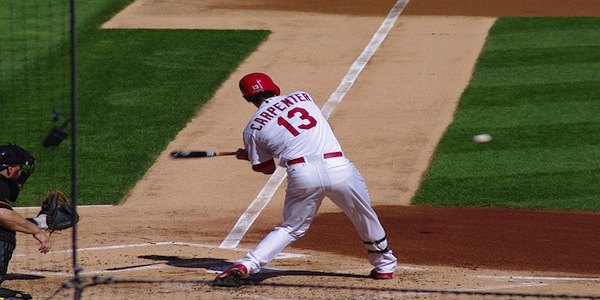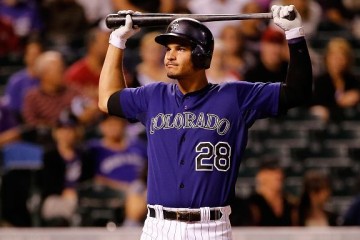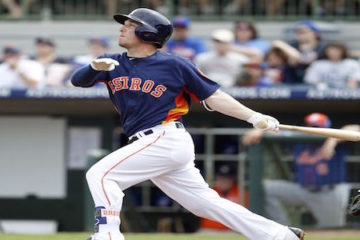Two to Add and Two to Dump: Third Base Edition

The common thread running through this series is that only fools run with their roster and never make changes from day one. The winners in fantasy baseball are never the ones who win the draft. That’s like winning the Winter Meetings for real baseball clubs. The winners are the ones that make the smartest trades and use the waiver wire to their advantage. Of course, making good draft day decisions is important, but it is not more important to maximizing each position by making moves to acquire players that will play well from here on out. It also means finding a new home for players that may have outkicked their coverage to this point.
I know many of you may be joining us for the first time, so let me reset the premise. We are looking at batted ball statistics. Batted ball statistics serve as good predictors for future performance. We can split those into two categories. First, we have the plate discipline and contact numbers. Contact rates are self-explanatory, but chase rates essentially catalog what percentage of balls out of the strikezone that the hitter swings at. The second category of numbers might be what we might call power potential. With that, we look at the percentage of balls that a player hits hard and the percentage of flyballs that turn into home runs.
This combination of metrics tells us whether a player’s batting average on balls in play matches the rate of contact and the type of contact he has been making. Some players fall below what we would expect and some have outproduced those expectations. The ones that fall below are players we should add. The ones that have outproduced those numbers are players we should trade. We could go with league averages on these numbers, but I have chosen to profile every regular at the position and spit out a median for each metric. That gives us a frame of reference as to what we would expect.
Contact: 77.6%
Chase: 27.8%
Hard: 41.7%
HR/FB: 13.3%
BABIP: .289
Two to Add
Jose Ramirez– Cleveland Indians
Yahoo: 98%
Contact: 83.8%
Chase: 27.1%
Hard: 37.4%
HR/FB: 8.0%
BABIP: .235
This is definitely a non-traditional add. Ramirez was picked in the first five rounds of nearly every league. Fantasy owners had 30/30 seasons bouncing around in their head. We may have to tamp down on those expectations, but he is definitely better than he has shown so far. Ramirez owners have not given up on him (as the owning rate shows) but they are probably trying to save face. You could probably offer fifty percent of his real value and have a taker. Of course, the added bonus is that he is available at second base and third base.
The key for Ramirez is that he still makes contact and he is close to the positional median in hard contact. This seems unbeliavavle for a guy with a .235 BABIP. That is doubly true when you consider he is an above average baserunner. The upshot is that his BABIP should be 60 to 70 points higher and that also means his batting average will likely be that much higher from here on out. Add in a little more luck on flyballs and he could be a 15/15 guy for the rest of the season.
Matt Carpenter– St. Louis Cardinals
Yahoo: 93%
Contact: 78.9%
Chase: 20.9%
Hard: 43.2%
HR/FB: 11.1%
BABIP: .264
Like with Ramirez, you would need to trade for Carpenter, but he might be able to be had for pennies on the dollar. Heck, the Cardinals have been giving him multiple days off and using him as a pinch hitter. Carpenter has elite plate discipline skills as only one regular has swung at a smaller percentage of pitches outside the zone (Alex Bregman). Those of you in five category leagues may not care about walks, but good plate discipline also means swinging at better pitches. That might mean hitting the ball harder more often.
Carpenter is not underproducing by a lot. He has a career .315 BABIP, but let’s assume he could hit .300 from this point forward. It would mean him hitting between .250 and .260 the rest of the way. Add in an additional home run or two and that could be .260/.350/15/50/50 for the remainder of the season. That might not be better than your starting third baseman, but I imagine it would be for some of you.
Two to Dump
Yoan Moncada– Chicago White Sox
Yahoo: 86%
Contact: 69.3%
Chase: 31.3%
Hard: 36.7%
HR/FB: 19.6%
BABIP: .367
It’s hard treating players like stocks. If I were a White Sox fan I would be encouraged by the growth that he and Tim Anderson have shown this season. As a fantasy owner I would be shopping both around the league. He set the world record for strikeouts last season and this year has been better. His strikeout rate is five percent better this season than it was last season. It is great that he is making progress, but he is still way too swing and miss to be a consistent offensive force.
He has things to offer in fantasy. He has some pop and some speed. He also will draw a walk or two. Those are things you can sell to someone in your league. If you are smart you can get $1.25 value on the dollar. Don’t oversell it and make sure you have a backup plan at second or third. You might be able to add a good outfielder or pitcher that is destined to play better down the stretch.
Rafael Devers–Boston Red Sox
Yahoo: 87%
Contact: 77.5%
Chase: 37.5%
Hard: 35.2%
HR/FB: 14.8%
BABIP: .356
Just like with Moncada, real baseball and fake baseball diverge at the road. There are lots of reasons to be optimistic about Devers long-term. However, if you are only playing for this season you have to look at the numbers and expect regression. Someone in your league just might pay you premium value for a player that likely won’t perform at a premium level for the remainder of the season. He’s not striking out as often as he did in his first two seasons, but there is little reason to believe he will keep producing at a .316/.372/.498 clip. Keep in mind this is a a career .270/.327/.462 player.
He will likely end up with better numbers than that, but those second numbers will likely be closer to how he finishes the last four months. Granted, that’s not bad and certainly worthy of ownership, but you might as well trade high while you can. There are any number of third basemen that can produce the second set of numbers. You can add one of those and use Devers to help you upgrade at another position.



